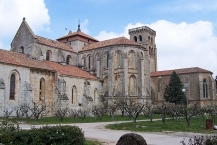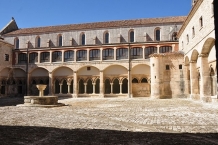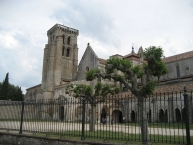The Way of El Cid Cycle Route
Actions
![]()
Please wait - map data are loading
Added on 01 Aug 2017,
last edited by biroto-Redaktion on 07 Feb 2021
Actions
Cycle route metrics
Total distance in km
1.379
Information about rights to the gps-track data | |
|---|---|
Rights owner | OpenStreetMap and Contributors + biroto-Redaktion (biroto.eu) |
Rights characteristic / license | Contains information from OpenStreetMap, which is made available here under the Open Database License(ODbL) |
Link to the description of the license | |
GPX file taken from | |
GPX file uploaded | by biroto-Redaktion on 03 Feb 2021
|
Track points in total
20.213
Track points per km (avg)
15
Start/endpoint
Start location
Quintanilla Vivar, Castile and León, ES (855 m NHN)
End location
Orihuela, Valencian Community, ES (27 m NHN)
Character
The Way of El Cid is a cultural and tourist route that crosses Spain from the northwest to the southeast, from Castilla to the Mediterranean coast. It follows the history and the legend of Rodrigo Díaz de Vivar, El Cid Campeador, a medieval knight of the 11th century and one of Spain’s greatest characters. El Cid is not only a literary character, also a historical figure.
The main travel guide on the route is the Cantar de mio Cid, the great Hispanic medieval epic poem written at the end of the 12th century or beginning of the 13th. It tells of the adventures of El Cid Campeador as from his exile, fighting to survive against Moors and Christians.
The route crosses eight Spanish provinces (Burgos, Soria, Guadalajara, Zaragoza, Teruel, Castellón, Valencia and Alicante) belonging to four Autonomous Communities (Castile and Leon, Castilla-La Mancha, Aragon and Valencian Community).
Origins of the Camino del Cid
The Camino del Cid is an itinerary inspired by El Cantar de mio Cid. In it, the author makes references to both history and fiction. The route taken by the historic Cid does not correspond exactly with that described in the poem. The author would have used available historical references added to his own knowledge of geography to draw a route traced mainly by Roman roads, trade routes, and historic paths. This network of paths, some of which still exist today, began to be traveled as itineraries of the Cid towards the end of the nineteenth century by Archer Milton Huntington, founder of the Hispanic Society of America, followed shortly thereafter by the search for traces of the Cid through the Castilian and Aragonese lands by the philologist Ramón Menéndez Pidal and his wife Maria Goyri.
With only a few exceptions, travellers will come across all the scenarios mentioned in the poem on this route. In some cases, some villages have been associated with the same place name, as is the case of El Robledal de Corpes. The location of this place, which is where the imaginary affront to El Cid's daughters occurs, has captured the attention of many academics.
Road cycling tourism routes
The road cycling routes on the Way of El Cid (touring, trekking, hybrid and road bikes) are on mainly quiet minor roads with little or hardly any traffic. However, there are also some sections along regional and national roads and connections to dual carriageways: in general, but not always, these roads have a generous hard shoulder.
The cycling tourist routes are suitable to cyclists with all kinds of bikes: from road to all-terrain. The bikes best suited to these routes are the gravel´s and the touring bikes (also called trekking, or hybrid) owing to their versatility: In comparison with mountain bikes, touring and gravel bikes are faster, especially on flats and downhill sections. They are more comfortable than racing bikes when the road surface is in bad condition or wet, but they also let tourists change over to the mountain bike routes (MTB): many sections are very easy and comfortable for trekking bikes.
The Way of el Cid credential
The Letter of Safe Conduct is the credential that features the stamps of the various towns and villages travellers pass through. It is based on the document used during the Middle Ages to ensure that travellers and goods were allowed to travel freely and safely.
It is a memento of the experience travelling the Way of El Cid: the stamps are much sought-after. The collection was designed by Julián de Velasco. Also it It is a way of discovering the history of the towns and villages pass through The Way of el Cid: each stamp reminds of a historic or legendary event, or part of the local heritage.
The Letter of Safe Conduct entitles to discounts of around 10% at more than two hundred accommodation options on the Way of El Cid. In addition, can use the Letter of Safe Conduct to take advantage regular promotions and free gifts, including bracelets, badges, caps, bandolera scarves and T-shirts, etc. If collect four stamps from at least seven of the eight provinces the Way passes through, will receive the Way of El Cid certificate free of charge.
The Letter of Safe Conduct is free of charge, can be apply by mail or asking in person at any of the 81 Tourist Information Offices located along the Way of El Cid.
Information about copyright | |
|---|---|
Rights characteristic / license | by-sa: CREATIVE COMMONS Attribution-ShareAlike |
Link to the description of the license | |
Input taken over from: |
Wikipedia contributors, 'Camino del Cid', Wikipedia, The Free Encyclopedia, 30 December 2020, 11:14 UTC, https://en.wikipedia.org/w/index.php?title=Camino_del_Cid&oldid=997188898 [accessed 7 February 2021] |
taken over / edited on | 07 Feb 2021
|
taken over / edited by |
|
Signposting
|
Sources of information
Web-Sites:
Beds4Cyclists, worth visiting and infrastructure
Name and address
Latitude / Longitude
Phone
Fax
Mobile
Type of accommodation
Rating for cyclists
Route km
Dist. to route
Elevation
0 km
0,1 km
862 m
11 km
0,9 km
845 m
Information about copyright | |
|---|---|
Rights owner | |
Rights characteristic / license | by-sa: CREATIVE COMMONS Attribution-ShareAlike |
Link to the description of the license | |
Image taken over from | commons.wikimedia.org/wiki/File:Burgos_monasterio_huelgas_lou.JPG |
Image has been uploaded | by biroto-Redaktion on 15 Mar 2015
|
Information about copyright | |
|---|---|
Rights owner | |
Rights characteristic / license | by-sa: CREATIVE COMMONS Attribution-ShareAlike |
Link to the description of the license | |
Image taken over from | commons.wikimedia.org/wiki/File:Monasterio_de_las_Huelgas,_Claustro_de_San_Fernando.JPG |
Image has been uploaded | by biroto-Redaktion on 15 Mar 2015
|
Information about copyright | |
|---|---|
Rights owner | |
Rights characteristic / license | by-sa: CREATIVE COMMONS Attribution-ShareAlike |
Link to the description of the license | |
Image taken over from | |
Image has been uploaded | by biroto-Redaktion on 15 Mar 2015
|
The Abbey of Santa María la Real de Las Huelgas is a monastery of Cistercian nuns located approximately 1.5 km west of the city of Burgos . The word huelgas, which usually refers to "labor strikes" in modern Spanish, refers in this case to land which had been left fallow. Historically, the monastery has been the site of many weddings of royal families, both foreign and Spanish, including that of Edward I of England to Eleanor of Castile in 1254, for example. The defensive tower of the Abbey is also the birthplace of King Peter I of Castile.
The abbey was founded in 1187 by Alfonso VIII of Castile, at the behest of his wife, Eleanor of England, daughter of Henry II of England and Eleanor of Aquitaine. Until the 16th century, it enjoyed many royal privileges granted to it by the king, including exemption from taxes, the lordship of many villages and territories (governed by the monastery's abbess), and the possession of many of the royal families' valued personal items, most of them religious. It is even claimed that, until the Council of Trent, the abbess was able to hear confession and give absolution, like a priest.
In 1199 the monastery was incorporated into the Cistercian Order and became the burial place of the royal family. Constance, the youngest daughter of Alfonso, joined the Cistercians there. She was the first known as the Lady of Las Huelgas. This position was held as well by other women from the royal family, including her niece Constance and her grand-niece Berengaria, and maintained the close connection between the community and their royal patrons. Queen Eleanor and Queen Berengaria were both documented as supporting and being involved with the abbey.
Alfonso VIII, who was himself to be buried at Las Huelgas, along with his wife, Eleanor, created the affiliated Royal Hospital, with all its dependencies, subject to the Abbess. The hospital was founded to feed and care for the poor pilgrims along the Camino de Santiago. Donations made to sustain the hospital noted the key role that Eleanor played in its founding and maintenance, and she made many donations in honor of her deceased son Ferdinand.
A community of lay brothers developed to help the nuns in their care of the hospital's patients, who became known as the Brothers Hospitallers of Burgos. There were never more than a dozen of them, but they formed an independent religious Order in 1474. The Brothers survived as an Order until 1587, when their Order was suppressed and they were again placed under the authority of the abbess.
The Abbess of the monastery was, by the favor of the king, invested with almost royal prerogatives, and exercised an unlimited secular authority over more than fifty villages. Like secular lords, she held her own courts, in civil and criminal cases, and, like bishops, she granted Dimissorial Letters for ordination, and issued licenses authorizing priests within the territory of her abbatial jurisdiction to hear confessions, to preach, and to engage in pastoral care. She was privileged also to confirm the Abbesses of other monasteries, to impose censures, and to convoke synods. At a General Chapter of the Cistercians held in 1189, she was made Abbess General of the Order for the Kingdom of León and Castile, with the privilege of convoking annually a general chapter at Burgos.
The Abbess of Las Huelgas retained her ancient prerogatives up to the time of the Council of Trent, in the 16th century.
Currently, the monastic community, which at present numbers 36, is part of the Spanish Congregation of St. Bernard, a reform movement of Cistercian nuns, which arose during the 16th and 17th centuries. Due to this, they are also commonly referred to as "Bernadines". The nuns of this Congregation would follow a more exact observance of the Rule of St. Benedict than other Cistercian houses, with frequent and lengthy fasts, and celebrating the Divine Office about 2:00 A.M. The nuns support themselves through the decoration of porcelain items, making rosaries and providing laundry services for local hotels.
This abbey has founded a daughter house in Peru, the Monastery of the Most Holy Trinity, which is located in the agricultural Lurín District, on the outskirts of the Lima Metropolitan Area. The monastery has about ten professed nuns, and several candidates in various stages of formation. They support themselves by making cakes and jams, for which they use the produce of their own gardens.
Information about copyright | |
|---|---|
Rights characteristic / license | by-sa: CREATIVE COMMONS Attribution-ShareAlike |
Link to the description of the license | |
Input taken over from: |
Wikipedia contributors, 'Abbey of Santa María la Real de Las Huelgas', Wikipedia, The Free Encyclopedia, 13 October 2014, 22:49 UTC, <http://en.wikipedia.org/w/index.php?title=Abbey_of_Santa_Mar%C3%ADa_la_Real_de_Las_Huelgas&oldid=629501072> [accessed 15 March 2015] |
taken over / edited on | 15 Mar 2015
|
taken over / edited by |
|
Hours of opening
Tuesday to Saturday: 10:00 to 13: 00h and 16:00 to 17: 30h
Sundays and holidays: 10: 30h to 14: 00h.
Closed: Monday; 1 and 6 January; Good Friday; May 1; Curpillos; 29 June; 6, 24, 25 and 31 December
12 km
0,1 km
876 m
12 km
0,1 km
876 m
12 km
0,0 km
863 m
Hours of opening
September 30 to June 30
from Monday to Saturday from 10:00 to 14:00 and 16:00 to 19:00
Sunday 10:00 to 17:00
July 1 to August 31
from Monday to Sunday 10:00 to 8:00 p.m.
![]()




